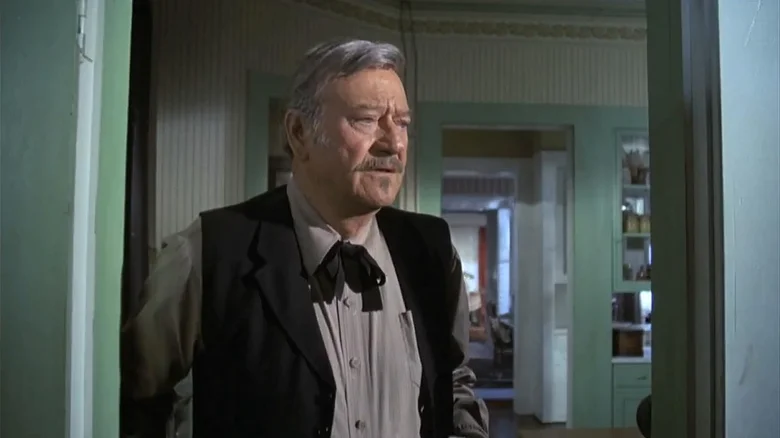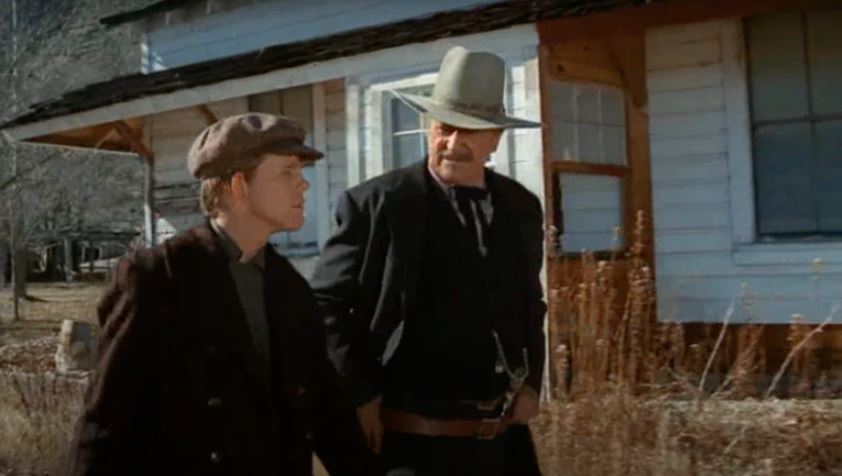When principal photography commenced on “Rooster Cogburn” in the fall of 1974, John Wayne was 68 years old and not thinking about retirement. By the end of the shoot, the star was on oxygen after contracting viral pneumonia. Almost a year later, when it came time to promote the film’s theatrical release (a big deal given that this was the sequel to “True Grit,” which earned the Duke his first Academy Award for Best Actor), Wayne was MIA due to the same lingering case of pneumonia — a frightening proposition given that the longtime smoker had lost a lung to cancer a decade prior.
If Wayne wasn’t well enough to do a perfunctory round of interviews, he certainly wasn’t in good enough shape to shoot another movie. But the star was determined to get back in the saddle and justified his eagerness by pointing out that he was still cancer-free. Even with one lung, a persistent cough wasn’t going to take down the Duke. According to Scott Eyman’s excellent biography, “John Wayne: The Life and Legend,” when asked in 1975 why he was so hellbent to keep working, the star replied, “I’m very conscious that now I know more dead people than live ones. But I don’t try to live back there. I try to live in tomorrow.”

The trouble with tomorrow was that the worsening heart problems Wayne had been hiding would still be there. Nevertheless, he persisted, and when producer Mike Frankovich couldn’t persuade big names like George C. Scott, Gene Hackman, Charles Bronson, Clint Eastwood, and Paul Newman to star in his elegiac Western “The Shootist,” the role went to the legend best suited to play a headed-out-to-pasture gunfighter whose bloody past is fixing to catch up with him. How did it turn out?
A dying John Wayne plays a dying gunfighter in Don Siegel’s The Shootist
Directed by the great Don Siegel, who’d gone from being one of the studios’ most dependable B-movie journeymen to Hollywood’s A-list on the strength of the commercial and (mostly) critical success of 1971’s “Dirty Harry,” “The Shootist” leisurely tells the tale of one John Bernard “J.B.” Books, a former sheriff who’s been playing out the string as a gunfighter. A man like Books can generally expect a violent end, so he’s somewhat disheartened to learn from a small-town doctor (James Stewart) that he is rapidly dying of terminal cancer.
Books has the opportunity to go peacefully but not painlessly. Suicide seems to be the most attractive option, but Books instead has the local boy who’s become attached to him (Ron Howard) invite three vengeance-seeking relatives of men he’s killed in the past to meet him at a bar on a specific date and time. That day is Books’ birthday.

Working from a screenplay by Scott Hale and Miles Hood Swarthout (the latter adapting the novel of same title written by his father, Glendon Swarthout), Siegel resists the B-movie urge to deliver the tight 80-minute pulp flick the material easily could’ve been and instead gives Wayne a tough, semi-sentimental sendoff. Stewart and Howard are joined by other Hollywood legends like Lauren Bacall, John Carradine, Richard Boone, Scatman Crothers, and Sheree North, all of whom seem aware of this modestly scaled film’s heavy showbiz gravity. It wasn’t hard to see that this was the Duke’s swan song. Had the film’s insurers played hardball, “The Shootist” likely would’ve never been made. Also, while filming in the high altitude of Carson City, Nevada, Wayne struggled to breathe and had to endure a daily regimen of getting phlegm pounded out of his one remaining lung.
As Quentin Tarantino wrote for The New Beverly Cinema’s website in 2019, “There’s nothing in ‘The Shootist’ you haven’t seen done many times before and done better … but what you haven’t seen before is a dying John Wayne give his last performance.” This is a fair assessment. It is a little pokey in the early going, but watching Wayne bulldog his way through the movie makes for a fitting farewell to arguably the biggest movie star of the 20th century. Wayne might’ve been a bastard off the screen (a product of his time, to be very charitable), but the classic movies he left behind endure like none other.
